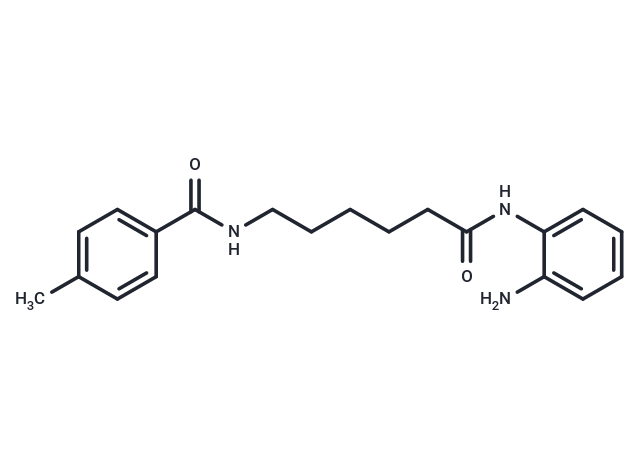Shopping Cart
- Remove All
 Your shopping cart is currently empty
Your shopping cart is currently empty

RG2833 (RGFP109) (RGFP109), a brain-penetrant HDAC inhibitor, is with IC50 of 60 nM and 50 nM for HDAC1 and HDAC3, respectively.

| Pack Size | Price | Availability | Quantity |
|---|---|---|---|
| 5 mg | $30 | In Stock | |
| 10 mg | $52 | In Stock | |
| 25 mg | $62 | In Stock | |
| 50 mg | $73 | In Stock | |
| 100 mg | $119 | In Stock | |
| 200 mg | $198 | In Stock | |
| 1 mL x 10 mM (in DMSO) | $31 | In Stock |
| Description | RG2833 (RGFP109) (RGFP109), a brain-penetrant HDAC inhibitor, is with IC50 of 60 nM and 50 nM for HDAC1 and HDAC3, respectively. |
| Targets&IC50 | HDAC1:32 nM(Ki), HDAC3:5 nM(Ki) |
| In vitro | In unstimulated peripheral blood mononuclear cells, RG2833 upregulates the level of the synaptic mRNA and protein in a dose-dependent manner. |
| Kinase Assay | Aconitase activities are determined by homogenization of mouse brain tissues on ice at 10% w/v in CellLytic MT Mammalian Tissue Lysis/Extraction buffer, followed by centrifugation at 800×g?for 10?min at 4°C. Tissue lysates (50?μL) are then added to 200?μL of substrate mix (50?mM Tris/HCl pH 7.4, 0.4?mM NADP, 5?mM Na citrate, 0.6?mM MgCl2, 0.1% (v/v) Triton X-100 and 1U isocitrate dehydrogenase) and the reactions are incubated at 37°C for 15?min, followed by spectrophotometric absorbance measurements every minute for 15?min at 340?nm 37°C to determine the reaction slope. Aconitase activities of mouse brain tissues are then normalized to citrate synthase activities, which are determined using a citrate synthase assay kit. |
| Alias | RGFP109 |
| Molecular Weight | 339.43 |
| Formula | C20H25N3O2 |
| Cas No. | 1215493-56-3 |
| Smiles | Cc1ccc(cc1)C(=O)NCCCCCC(=O)Nc1ccccc1N |
| Relative Density. | 1.163 g/cm3 (Predicted) |
| Storage | Powder: -20°C for 3 years | In solvent: -80°C for 1 year | Shipping with blue ice. | ||||||||||||||||||||||||||||||||||||||||
| Solubility Information | DMSO: 45 mg/mL (132.58 mM) Ethanol: 10 mg/mL (29.46 mM) | ||||||||||||||||||||||||||||||||||||||||
Solution Preparation Table | |||||||||||||||||||||||||||||||||||||||||
Ethanol/DMSO
DMSO
| |||||||||||||||||||||||||||||||||||||||||

Copyright © 2015-2024 TargetMol Chemicals Inc. All Rights Reserved.